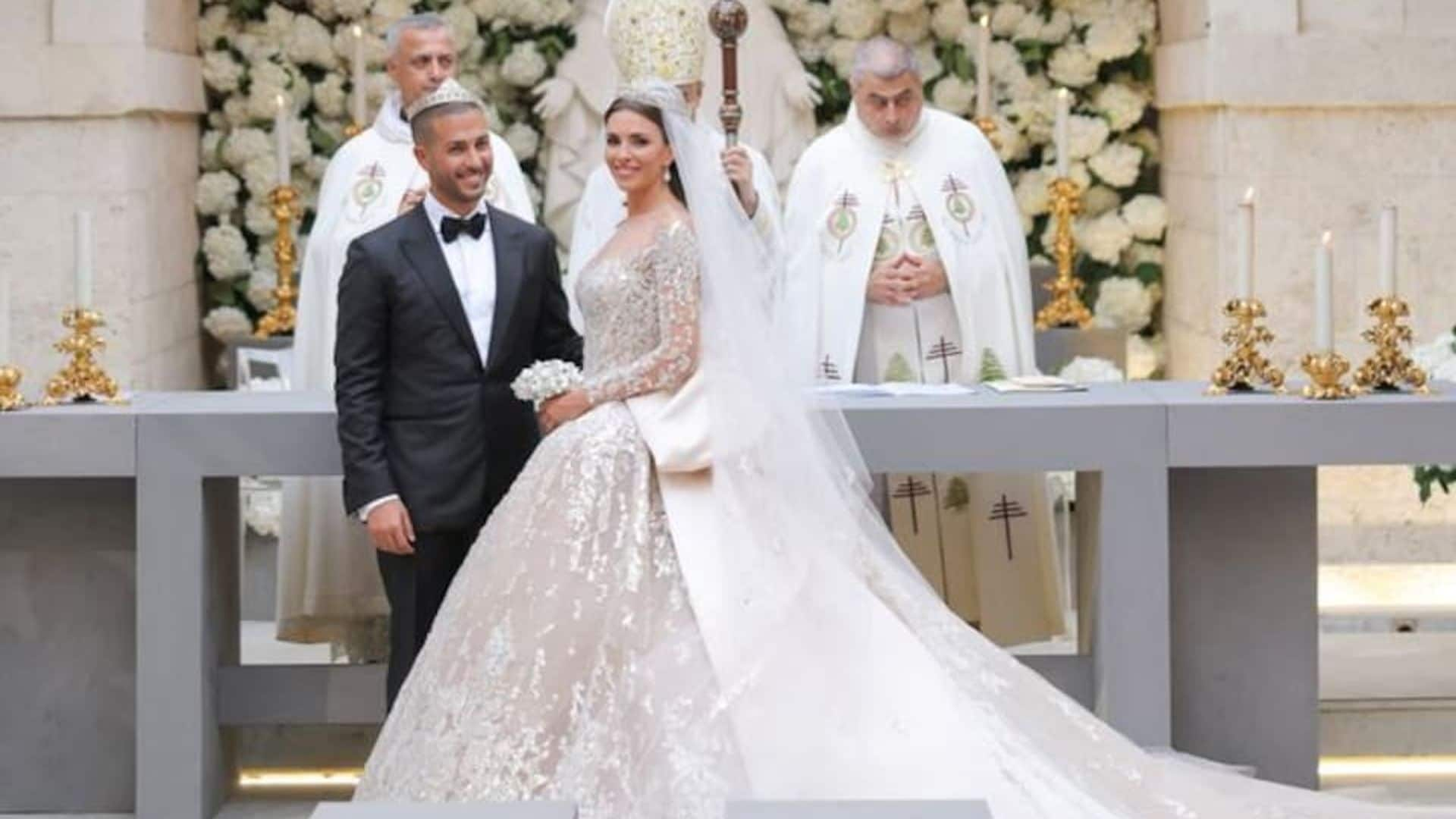Some weddings feel like they’re straight out of One Thousand and One Nights, and then there’s Zein Qutami and Celio Saab’s. A celebration in three acts, it unfolded between the sunset-drenched mountains of Faqra and the solemn grandeur of Bkerke Church in the heart of Lebanon.
A guest list full of stars and elegance
Zein Qutami and Celio Saab’s wedding brought together some of the most recognizable faces from Lebanon and beyond. Lebanon’s First Lady, Neemat Aoun, attended the wedding, adding a special touch of honor to the event. The guest list included Spanish top model Nieves Álvarez, Salma Abu Deif, Hande, Nadine Njeim, Cyrine Abdelnour, and singer Balqees. Fashion personalities like Karen Wazen, Nathalie Fanj, and Nour Arida were also there, making the celebration feel like a red carpet wrapped in candlelight and couture.
A Lebanese fairytale set between Faqra and Bkerke
The majestic setting was a sign from the start: the marriage was no ordinary union. Elie Saab, the undisputed emperor of Lebanese couture, is the bride's father-in-law, so a simple ceremony is out of the question. And indeed it became an opera told in three gowns.
The story began with the prewedding celebration, a welcome dinner held Thursday night at Panorama Faqra, a place full of personal meaning for Celio, son of the designer and heir to the Saab empire. Set against a backdrop of miniature palm trees and rugged hillsides, Zein made her first unofficial bridal appearance in a rose sand gown with an ethereal cape embroidered with the maison’s signature shimmering arabesques
The event’s palette of olive, earth, and greige allowed Zein’s silhouette to float like an apparition among the guests. The effect was more tribal queen than bride. Zein embodied a minimalist Cleopatra in the realm of couture.
“This dress was a celebration of Lebanese identity, a piece designed to blend with the natural landscape and rustic architecture of the setting,” Zein explained. “We wanted something that wouldn’t compete with the surroundings but would speak the same language.”
Friday was the day of the religious ceremony held at the imposing Church of Bkerke, the seat of the Maronite Patriarchate.
In this sacred and majestic setting, Zein wore a gown that seemed carved from light: long sleeves, a strapless neckline, a structured corset, and cascading silver embroidery flowing into a princess skirt. A trailing bow softened the gown’s architecture, and the veil, as long as the promise of marriage itself, completed the image of a classic bride touched with that otherworldly aura Elie Saab alone can create when dressing a woman to walk down the aisle.
“We knew this would be the most symbolic dress. I wanted something that felt timeless. Elie and I worked together on every detail,” said Zein. Zein said, "What struck me most was his deep understanding of my style and personality, which allowed him to create something spectacular and intimate." “I felt entirely myself while simultaneously experiencing a transformation, which is precisely how a bride should feel.” I felt completely myself and transformed at the same time. Exactly how a bride should feel.”
The gown in all its meticulous detail recalled the grand ball dresses of Austro-Hungarian empresses or the royal brides of twentieth-century romance elevated to the level of ritual.
But like every great contemporary wedding, the ceremony wasn’t the end; it was just the beginning. On Saturday night the couple hosted one final celebration at the Saab family residence in Faqra: an open-air dinner in the woods with candlelight flickering like fireflies and a fairytale atmosphere
Zein transformed once again for that final evening, which the program described as “one last night before the sun takes over.” She transformed into a nighttime diva, donning a champagne mermaid-cut gown featuring a deep V neckline and a 4.5-meter overskirt. The embroidery lines, crystals, sequins, and translucent diamond-shaped stones evoked both the shimmer of water and the intricate geometry of an imagined souk.
“The final dress was an homage to Lebanese glamour, to the golden age of Beirut, and to the woman who celebrates with intensity,” Zein shared. “I wanted something bolder, more sensual, but without losing the sophistication that defines Saab’s style.”
“I felt free, happy, and powerful.”
In total, there were three dresses, each possessing its own narrative rhythm and tone; as Zein herself noted, they didn’t tell the same story but spoke a common language, which was defined by Elie Saab’s embroidered details that appear to stitch together airy silhouettes that float while maintaining structure. Elie Saab achieved luxury without resorting to ostentation.
Zein wasn’t just dressed by a master; she was guided through the symbolic journey from bride-to-be to wife by an artist who also considers her family. And in the world of haute couture, where everything is usually defined by ego or exclusivity, that is something rare.
While many brides wrestle between tradition and individuality, Zein managed to embrace both with a calm rarely seen. It wasn’t just that she looked beautiful, which she did, but that she rose to meet the dress, the moment, and the name she now carries.
A Lebanese-style prewedding bash to remember
More than a thousand guests gathered for an unforgettable Lebanese-style prewedding celebration ahead of the ceremony at Bkerki Church, overlooking Jounieh Bay.
The party in Faqra was a warm cultural welcome for over 1,500 attendees. There were no speeches or formalities, just a joyful celebration of love. Every detail was thoughtfully planned to blend fashion, landscape, and tradition, marking the beginning of a wedding with strong social and cultural significance.
